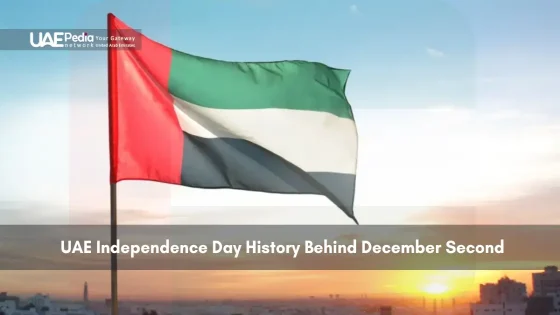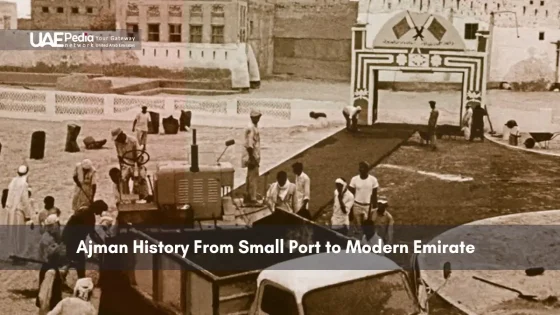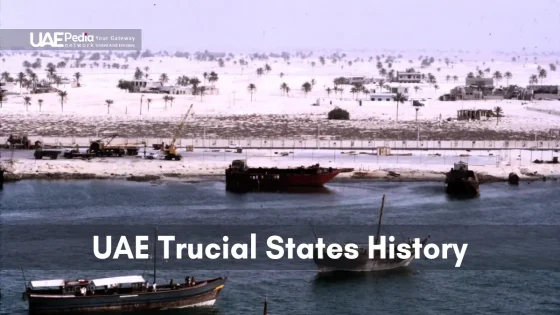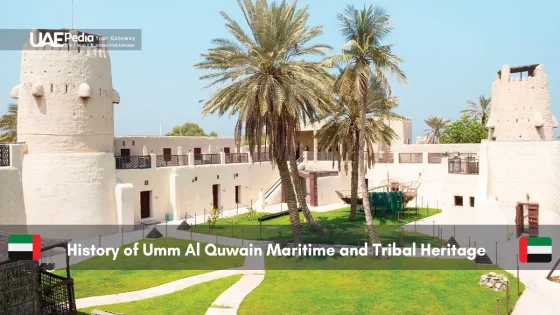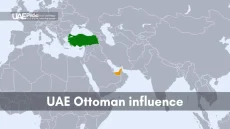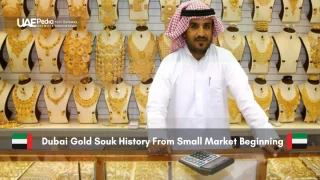What if the gleaming skyscrapers and bustling souks of today’s Emirates trace back to one pivotal winter morning? On December 2, 1971, a quiet desert horizon gave way to a bold new chapter—the birth of a united federation. Seven distinct regions chose unity over division, creating a blueprint that transformed arid landscapes into global hubs.
This moment—now celebrated as Eid Al Etihad—wasn’t just about political shifts. It marked the culmination of tribal diplomacy, visionary leadership, and a collective hunger for self-determination. With British forces withdrawing, local rulers like Sheikh Zayed bin Sultan Al Nahyan forged alliances that balanced tradition with ambition.
Ras Al Khaimah’s decision to join the federation months later sealed the deal. Together, these regions crafted a story of resilience that still echoes in fireworks over Burj Khalifa and traditional ayyala dances during festivities.
Key takeaways:
- December 2nd symbolizes the fusion of seven regions into a thriving modern identity
- National Day honors both historical unity and ongoing cultural evolution
- Leadership choices during the 1971–72 period shaped today’s regional dynamics
The Historical Context of a Unified Nation
Imagine standing on a 1960s Arabian Gulf beach—not a skyscraper in sight—where scattered pearl-diving villages faced a crossroads. This was the reality for the Trucial States, a cluster of territories bound by 19th-century British treaties. Their path to unity? Far from smooth.
Pre-Independence Challenges and the Trucial States
Before becoming the united arab federation, these states juggled tribal rivalries and scarce resources. Freshwater was fought over like gold. External pressures loomed too—neighboring powers eyed their strategic coastline. Yet shared hardships planted seeds for collaboration.
The Influence of Regional Powers and British Withdrawal
Britain’s 1968 decision to withdraw forces sparked urgency. While their presence had stabilized trade routes, it also delayed self-governance. Local leaders saw an opening: unite or risk fragmentation. As one diplomat noted, “The British exit wasn’t an ending—it was a starting pistol.”
| Factor | Pre-1971 Challenges | Post-Unification Progress |
|---|---|---|
| Governance | Separate tribal leaderships | Federal council system |
| Economy | Pearl diving & limited trade | Oil diplomacy & global ports |
| Symbols | Local banners | Unified flag design |
This era birthed more than political change—it forged cultural touchstones. The now-iconic flag, with its Pan-Arab colors, first flew in 1971. Annual days of remembrance evolved into today’s vibrant National Day festivities. Want the full story? Our deep dive into the Trucial States era reveals how fragile alliances became unshakable bonds.
uae independence day history: Uniting the Emirates
Picture this: seven puzzle pieces scattered across golden sands, each shaped by distinct traditions. Now imagine two hands carefully fitting them together—those of Abu Dhabi’s Sheikh Zayed and Dubai’s Sheikh Rashid. Their 1971 collaboration didn’t just build a country. It crafted a legacy.
The Vision Behind the Federation
These rulers saw beyond tribal boundaries. While others debated oil rights, they hosted majlis gatherings—open forums where compromise trumped conflict. “We either stand together,” Sheikh Zayed famously urged, “or we vanish alone.” Their blueprint blended local autonomy with shared infrastructure, creating a union stronger than its parts.
Key Moments Leading Up to December 2nd
The road to unification had pivotal stops:
- March 1968: Secret meetings between Abu Dhabi and Dubai leaders
- July 1971: Six emirates signing the provisional constitution
- November: Ras Al Khaimah’s temporary pause, later reversed
Sheikh Zayed becoming first president wasn’t mere protocol. It signaled trust across regions. His team launched federal institutions within months—central banks, defense forces—proving this wasn’t a paper alliance. As December 2nd dawned, radio broadcasts carried declarations in coastal dialects and mountain accents alike. A mosaic became a masterpiece.
Cultural Celebrations and National Pride
As dusk falls on December 2nd, the Emirates transforms into a canvas of red, green, white, and black. Balconies drip with fairy lights shaped like falcons, while shop windows glow with portraits of visionary leaders. This isn’t just a holiday—it’s a sensory love letter to unity.
Traditional Festivities and Fireworks Displays
Locals begin mornings with ghawa (Arabic coffee) served in family courtyards. Children wave miniature flags, their laughter blending with the rhythmic stomp of ayyala dancers. Come nightfall, skies erupt in chrysanthemum-shaped explosions—grand fireworks painting Burj Khalifa in cascading gold.
Modern Celebratory Trends and Public Gatherings
New traditions thrive alongside old. At Zayed Sports City Stadium, laser shows project Sheikh Zayed bin Sultan Al Nahyan’s iconic smile across 50,000 faces. Global Village becomes a carnival of floating drones and Emirati pop stars. “Our celebrations,” notes a Dubai event planner, “honor roots while reaching for the stars.”
Pro tip: Arrive early at Abu Dhabi Corniche. Snag a spot near the Heritage Village tents—you’ll catch pearl-diving demos by day and synchronized fireworks by night. Don’t forget your kandura or abaya; wearing traditional attire unlocks warm smiles and photo ops with Bedouin storytellers.
From Trucial States to Federation: The Making of a Nation
Imagine a puzzle missing its final piece—until patience and diplomacy completed the picture. Six emirates shook hands under winter skies in 1971, their leaders signing documents that would reshape the Arabian Gulf. But the seventh piece, Ras Al Khaimah, lingered like a hesitant dancer waiting for the right rhythm.
The Process of Unification and Joining of Ras Al Khaimah
Ras Al Khaimah’s leaders initially held back, weighing concerns over resource sharing. Coastal winds carried whispers of doubt until February 1972, when they stepped forward—sealing the seven-emirate mosaic. “Unity isn’t about losing identity,” one negotiator remarked during the final majlis. “It’s about writing history together.”
Historical Milestones and Government Formation
The newborn federation moved swiftly. By March 1972, federal courts and a central bank emerged—concrete proof this wasn’t just symbolic. Annual celebrations became cornerstones, blending camel races with poetry recitals that honored both heritage and progress.
Key reforms smoothed the transition:
- Customs unions connecting desert trade routes
- Shared defense strategies protecting pearl-rich waters
- Education systems merging Bedouin wisdom with modern curricula
Today’s holiday parades mirror that 1972 spirit—fireworks bursting over Fujairah’s mountains while Ajman’s dhow sailors hoist the national flag. What began as cautious negotiations now fuels a legacy celebrated in every school play and street mural.
Legacy of Sheikh Zayed bin Sultan Al Nahyan and National Leadership
Think of a compass guiding ships through shifting sands—that was Sheikh Zayed’s role in shaping a country from scattered communities. His leadership blended Bedouin wisdom with forward-thinking diplomacy, turning whispered hopes into concrete progress. “The real asset,” he once said, “is the people—build them, and the nation builds itself.”
Leadership That Shaped the Nation
Sheikh Zayed’s hands-on approach broke barriers. He’d personally visit remote villages, listening to needs over cups of ghawa. This grassroots connection fueled decisions like investing oil wealth in schools and hospitals first—not palaces. Within years, literacy rates soared, and tribal disputes gave way to federal courts.
Vision for a Modern, United Country
His 1971 unification strategy was genius: let each emirate keep its identity while sharing resources. Dubai’s ports paired with Abu Dhabi’s oil, creating an economic powerhouse. Today’s founding father is celebrated in skyscraper designs echoing desert dunes—tradition meeting innovation.
The Continued Influence on National Identity
Walk through any souk, and you’ll spot his influence. Artisans weave his portrait into tapestries, while tech startups cite his risk-taking spirit. Annual events like the Zayed Humanitarian Day remind people that compassion remains core to the nation’s DNA. His legacy? A country where heritage fuels tomorrow’s dreams.
Reflecting on History: Insights and Future Aspirations
Every year, as fireworks bloom over futuristic skylines, the federation pauses to honor its roots—and imagine new horizons. The journey from desert councils to global stages reveals timeless lessons: unity thrives when vision meets action.
Zayed bin Sultan’s legacy lives in modern milestones. Leaders today, including the president, champion his collaborative spirit. They bridge traditions with tech-driven diplomacy, turning annual holidays into global showcases of heritage.
Consider the seventh emirate’s pivotal role. Its 1972 decision to join transformed the federation, blending coastal resilience with inland ingenuity. This diversity now fuels innovation, from AI-powered cities to Mars missions.
The date December 2nd isn’t just a marker—it’s a compass. Schools teach its significance, while artists reinterpret its meaning through holographic displays and spoken-word poetry. Even the world’s eyes turn here during Expo events and COP summits.
Looking ahead, expect celebrations merging Bedouin star navigation with quantum computing demos. The president’s recent pledge to plant 100 million mangroves by 2030 mirrors Zayed bin Sultan’s environmental ethos. Together, they remind us: progress honors the past while seeding tomorrow.
December 2nd marks the 1971 unification agreement signed by six emirates—Abu Dhabi, Dubai, Sharjah, Ajman, Umm Al Quwain, and Fujairah—to form a federation. Ras Al Khaimah joined weeks later, completing the seven-emirate union we know today. It’s a celebration of shared identity, not independence from colonial rule.
The Trucial States (pre-UAE emirates) were under British protection until 1968, when the UK announced its withdrawal. This prompted local rulers like Sheikh Zayed bin Sultan Al Nahyan and Sheikh Rashid bin Saeed Al Maktoum to pursue self-governance through collaboration, laying groundwork for the federation.
As Abu Dhabi’s ruler and the federation’s first president, Sheikh Zayed championed unity through diplomacy and resource-sharing. His vision transformed rival tribes into a cohesive nation, prioritizing education, infrastructure, and cultural preservation while embracing modernity.
The Trucial States were a loose group of emirates under British oversight from 1820 until 1971, each managing local affairs. The UAE replaced this structure with a federal government, blending autonomy for each emirate with centralized defense, foreign policy, and economic planning.
Initially hesitant about federal authority, Ras Al Khaimah’s leaders sought assurances on autonomy and resource rights. They officially joined on February 10, 1972, after negotiations addressed these concerns, finalizing the seven-emirate union.
